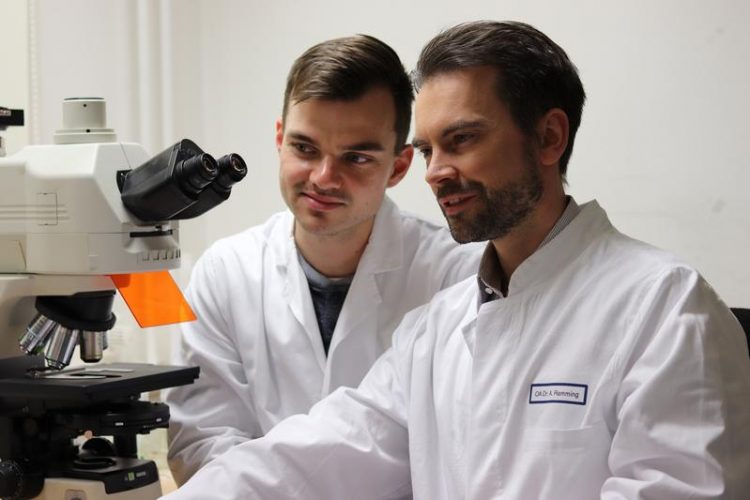Connective tissue on the wrong road – when organs start to scar

Doctoral candidate Thomas Wohlfahrt (l.), lead author of the article, and group leader Dr. Andreas Ramming in front of an immune fluorescence microscope. Image: Uni-Klinikum Erlangen
Scientists from Friedrich-Alexander-Universität Erlangen-Nürnberg (FAU), Department of Medicine 3 – Rheumatology and Immunology, headed by Prof. Dr. Georg Schett, have now decrypted a molecular network that controls these processes and could in future provide a new way to treat organ scarring.
The results show that the protein PU.1 causes pathological deposition of connective tissue. The scientists have now published their results in the renowned journal Nature.*
In connective tissue diseases such as systemic sclerosis, referred to collectively as ‘fibrosis’, excessive activation of connective tissue cells leads to hardening of the tissue and scarring within the affected organ. In principle, these diseases can affect any organ system and very often lead to disruption of organ function.
Connective tissue cells play a key role in normal wound healing in healthy individuals. However, if the activation of connective tissue cells cannot be switched off, fibrotic diseases occur, in which an enormous amount of matrix is deposited in the tissue, leading to scarring and dysfunction of the affected tissue. Until now, scientists did not fully understand why repair processes malfunction in fibrotic diseases.
An international team of scientists led by Dr. Andreas Ramming from the Chair of Internal Medicine III at FAU has now been able to decipher a molecular mechanism responsible for the ongoing activation of connective tissue cells.
In experimental studies, the researchers targeted the protein PU.1. In normal wound healing, the formation of PU.1 is inhibited by the body so that at the end of the normal healing process the connective tissue cells can return to a resting state.
‘We were able to show that PU.1 is activated in various connective tissue diseases in the skin, lungs, liver and kidneys. PU.1 binds to the DNA in the connective tissue cells and reprogrammes them, resulting in a prolonged deposition of tissue components,’ explains Dr. Ramming. PU.1 is not the only factor involved in fibrosis, as factors that are involved in the deposition of scar tissue have already been identified in the past.
What has been discovered now, however, is that PU.1 plays a central role in a network of factors controlling this process. ‘PU.1 is like the conductor in an orchestra,’ explains Ramming, ‘if you take it out, the entire concert collapses.’ This approach has already been tested using an experimental drug, fuelling the hope that clinical trials on inhibiting PU.1 may soon be able to be launched, aimed at treating fibrosis better.
The work was supported by Collaborative Research Centre 1181 ’Checkpoints for Resolution of Inflammation’ of the German Research Foundation.
Dr. Andreas Ramming
Phone: + 49 9131 85-39109
andreas.ramming@uk-erlangen.de
Media Contact
More Information:
http://www.fau.de/All latest news from the category: Health and Medicine
This subject area encompasses research and studies in the field of human medicine.
Among the wide-ranging list of topics covered here are anesthesiology, anatomy, surgery, human genetics, hygiene and environmental medicine, internal medicine, neurology, pharmacology, physiology, urology and dental medicine.
Newest articles

Properties of new materials for microchips
… can now be measured well. Reseachers of Delft University of Technology demonstrated measuring performance properties of ultrathin silicon membranes. Making ever smaller and more powerful chips requires new ultrathin…

Floating solar’s potential
… to support sustainable development by addressing climate, water, and energy goals holistically. A new study published this week in Nature Energy raises the potential for floating solar photovoltaics (FPV)…

Skyrmions move at record speeds
… a step towards the computing of the future. An international research team led by scientists from the CNRS1 has discovered that the magnetic nanobubbles2 known as skyrmions can be…





















